by Michelle Sutton
Homesteaders Sean Dembrosky in Trumansburg (Tompkins County) and Akiva Silver in Spencer (Tioga County) are making a full-time living growing nursery crops within a permaculture system. At its most essential, permaculture aims to mimic the structure of natural ecosystems to maximize productivity and sustainability. Food forests are a form of permaculture in which a woodland ecosystem is created with edible plants at every layer—trees, shrubs, climbing plants, perennials, and annuals.
In these conversations with Dembrosky and Silver, the concepts of permaculture and food forests begin to come to life. There’s so much more to explore. Fortunately, both men are passionate about sharing their extensive knowledge.
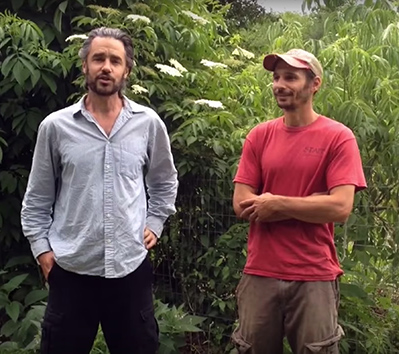
On Dembrosky’s YouTube channel, EdibleAcres, he and his wife Sasha have posted nearly 400 how-to videos for more than 40,000 subscribers; see also their website, edibleacres.org. Silver recently released his first book, Trees of Power: Ten Essential Arboreal Allies and posts technical and philosophical writing on his website, twisted-tree.net. He also hosts a YouTube channel, Twisted Tree Farm, and an online course—both focused on woody plant propagation.

SEAN DEMBROSKY / EDIBLE ACRES
I grew up in northern New Jersey where my Mom converted most of our tiny yard into food production, so I was always immersed in growing plants. I went to college for fine arts with a focus on computer graphics, but I was always gardening on the side wherever I was renting or in containers if no land was available.
The direction of my life was greatly influenced by an amazing professional photographer named Jon Naar who had traveled all over the world. A World War II vet who had met Gandhi, John was in his mid-80s when I met him. At his house in the middle of Trenton, he had a concrete backyard upon which he grew abundant veggies and fruits in massive soil-filled containers. When I came to a crossroads of either going all in on computer graphics or pursuing my interest in farming, John pushed me towards the latter. He saw where the world was heading in terms of fossil fuels and food security and thought that farming and sustainability would be a better use of my life.
Edible Acres happened over time; it wasn’t a buy-the-land-and-start-the-nursery sort of thing. I bought degraded, very low-cost land on top of a hill in Enfield, New York and started planting trees everywhere, training myself in permaculture, and making an unlimited number of mistakes! One key connection was with Stephen Breyer of Tripple Brook Nursery in Southampton, MA, who showed me his nursery system. It was very feral and loose, a wild food-forest style that he would dig up plants to sell from. It helped me see what was possible; before that, I always thought nurseries had to be high plastic tunnels, drip irrigation … lots of inputs and extra work.
At Edible Acres we are particularly interested in providing rapidly replicating plants for food forests. I see food forests as human-stewarded spaces that closely mimic forests or hedgerows, with an eye towards making food and medicine. Food forests are about the perpetual management of young forests; you’re hitting the reset button lightly, fairly often, to create the highest density, diversity, and number of interrelationships among all the species in the system—the plants, mammals, bugs—the whole shebang. This dynamic approach creates a really resilient and alive system.
Our little permaculture nursery in Trumansburg fully funds our whole life and that’s pretty exciting. We like the place we’re at and don’t want to grow the business just for the sake of getting bigger. This spring we’re shipping almost 300 separate orders from our tiny garage to places around the country.
This past year I’ve been particularly psyched with elderberry (Sambucus spp.) and black currants (Ribes nigrum), in part because with the massive deer and rabbit pressure that many people like us experience, these are shrubs that readily regrow after browsing. They are also easy to plant by cuttings by direct sticking in the earth; we can plant 15 to 20 per minute. The demand for nanking cherry (Prunus tomentosa)—from people and rabbits—is astronomical as well.
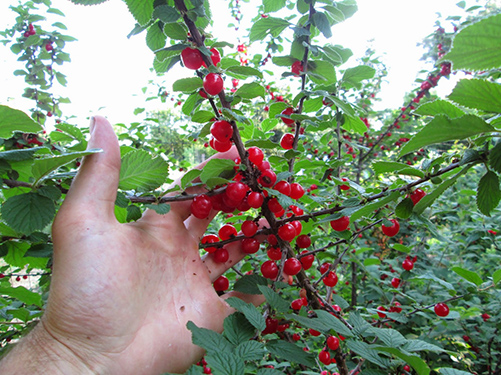
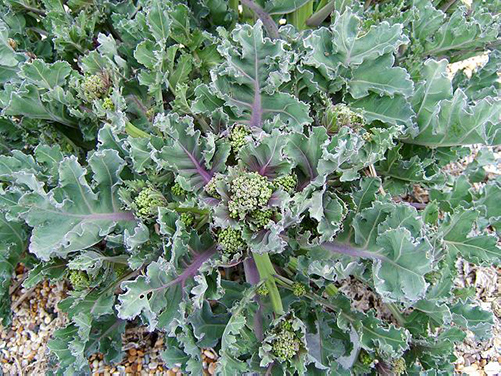
Plants have to be tough to grow here, and they grow stronger for it. Our main nursery has only one 10-x-30-foot area that has rabbit protection; other than that, 100 percent of the nursery is exposed to deer, rabbits, voles, and mice. We plant enough cuttings and seed to weather that pressure and still meet our financial needs. We have no irrigation, really poor soils as a starting point, very little sunlight, and the land floods in the winter and gets bone dry in the summer. In this way, it’s an intense testing ground! Once these tough plants get to gardens with cushier conditions, they really flourish.
There’s this limiting idea that in order to practice permaculture you have to design everything out in advance, an idea that can keep people from starting. Speaking from my experience after 15 years of not designing, it’s fine to just start planting and learn as you go. Permaculture overarchingly is a wonderful framework, but more than anything it’s the principles (permacultureprinciples.com) and ethics that I feel have the most value.
AKIVA SILVER / TWISTED TREE FARM
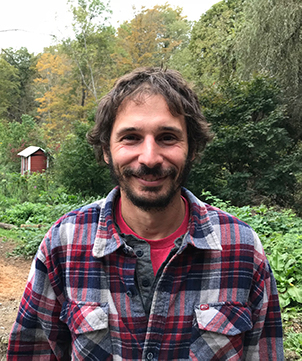
I became really interested in wilderness survival about 18 years ago and started spending all of my time in the woods to try to learn how to live off the land. However, the more time I spent in wilderness areas, the more I started to see that humans can have a positive impact on the world, like through planting trees. About 12 years ago, I started teaching myself plant propagation, focusing on trees and shrubs with food value for people and wildlife and medicinal and lumber value for people. It went from a hobby, to side income, to now selling more than 20,000 bare root seedlings of more than 100 varieties each year.
However much I produce, I can sell, but I don’t care to grow the business any larger; I want to keep life simple, and I choose to be satisfied where I’m at. I have help in the busy spring grafting and fall harvesting and shipping times, but most of the year it’s just me. Being able to work from home is what I always wanted, and really it was building a website and doing mail order that made this all possible. My wife Megan homeschools our three kids: Forrest, eight, Cyrus, six, and Oren, three.
Those who buy trees from us are gardeners, homesteaders, permaculture folks, wildlife conservationists, other nurseries, and even doomsday preppers. The wildlife conservation folks plant more trees than anyone, I find. They plant hundreds of thousands of chestnuts and chinquapins (Castanea spp.), hazelnuts (Corylus spp.), persimmons (Diospyros virginiana), apples (Malus spp.), pears (Pyrus spp.), and the like.

Spring is grafting season, planting the whole nursery, getting it all mulched, and then by May I weed and water and check on things. In the fall we dig up everything. We have a big festival in the fall called Nut Bonanza, a celebration of nut tree crops. There are stations for people to experience different tree crops, so we do hazelnut oil pressing, make hickory milk, crack black walnuts, roast chestnuts, and make acorn flour.
For someone who’s new to permaculture, I would suggest focusing on really easy-to-establish things that are high reward, like black currants and raspberries. These will build confidence to try more things. Start with building the soil and then putting in the smaller berry bushes. Eventually you can work your way up to fruit trees. Either way, you’ll want to spend significant time building your soil, much like you would prep soil for growing tomatoes—you’re striving for the crumbly, rich, well-drained soil that organic matter makes possible.
Fruit trees don’t have to be difficult; it depends on the type and the site. Persimmons and mulberries (Morus spp.) are very easy to grow, as are some apple tree varieties. If someone is wanting to put in a chestnut orchard and they’re on a clay hillside where wholesale amending of soil is not realistic, I would encourage them to create big berms or mounds by scraping any available topsoil downhill, then plant on those berms. If you’re growing in sandy soil, the task is to get as much organic matter into the system as possible. It could be raking up all the grass clippings in the area. Use what’s around you and nearby—I live near a saw mill so I use sawdust, which works great, and I use manure from a local dairy farmer. There’s not one right amendment or planting method; it depends on what you’re trying to do and what’s available.
In permaculture, I think the most important thing is to keep the soil covered. If you look at nature as an example, the earth naturally wants to be covered, either with plants or with leaves. If it’s not covered, all the organic matter is burning off really fast and nutrients are leaching out. Keep piling on the mulch, using materials around you, to protect the soil. The bacteria and worms and fungus are going to start working on that mulch, and that will make your soils alive. You can’t put those organisms there but you can create really good habitat and then the organisms will flourish—and they do the work of feeding the plants.
You know how you get inspired about different things in your life, but the feeling can pass fairly quickly? If you can act on it, it can grow into something amazing—and those amazing things are what’s going to heal the earth. You can’t know what chain reaction your actions will set into motion. For example, scientists introduced wolves back into Yellowstone Park with the initial intent of controlling elk and deer populations. Cognizant of the wolves, the elk and deer stopped feeding in open areas, including along riverways. The vegetation along rivers then exploded with growth, erosion was controlled, beavers came back, and the actual course of rivers was changed—all because wolves were reintroduced. In growing plants or in life in general, it’s important when you have those inspiration bombs to light them—don’t just put them away.
Trees of Power:
Ten Essential Arboreal Alliesby Akiva Silver
(2019, Chelsea Green Publishing)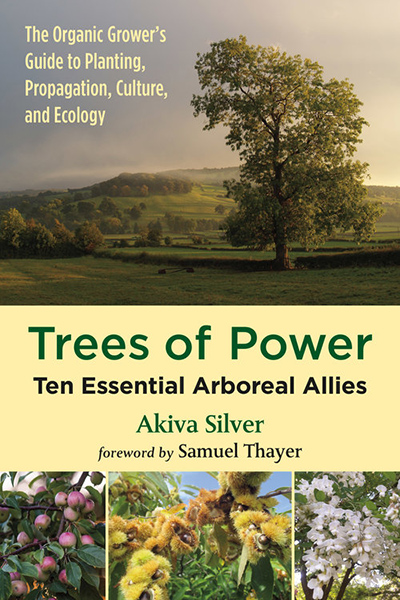
Silver’s first book, Trees of Power, is broken down into two parts. Part One teaches about propagation and planting skills. Part Two explores ten trees (Arboreal Allies) in depth:
Chestnut: The Bread Tree
Apples: The Magnetic Center
Poplar: The Homemaker
Ash: Maker of Wood
Mulberry: The Giving Tree
Elderberry: The Caretaker
Hickory: Pillars of Life
Hazelnut: The Provider
Black Locust: The Restoration Tree
Beech: The Root Runner
In the section on black locust, for instance, Silver explores how many different kinds of insects feed on the leaves and how important those insects are for bird populations, and how the flowers are edible and produce a huge nectar flow (Silver says they taste like sweet peas). “Black locust transforms landscapes, like places where they blow the top off a mountain and leave a wasteland, black locust is able to come in and transform no soil into soil,” Silver says. “It can fix carbon and nitrogen out of the air at extremely high rates. It’s pulling stuff out of the sky and putting it into the ground to set the stage for other things to grow again in abandoned pastures, roadsides—anywhere that’s been degraded.”
Another thing that makes black locust so valuable, Silver explains, is its rot resistance, which makes it ideal for boardwalks, docks, picnic tables, playgrounds, etc. New rules around docks, for instance, prohibit the use of treated lumber, so the options are tropical hardwood or black locust. “The demand for black locust is super high right now,” Silver says. “Fortunately, they grow so fast that by age seven to 10 you could be cutting the trees down and harvesting fence posts and they will regrow, giving you an endless supply. The regrowth on black locust with an established root system can be 10 feet in a year.”
Michelle Sutton is a horticulturist, writer, and editor living in New Paltz.
Views: 1




